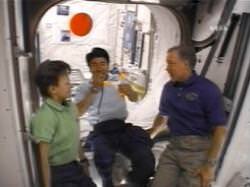Testing a boomerang in space might look and sound trivial, but it’s an exciting physics experiment that helps scientists to understand the dynamics of flight in microgravity. And now, one aspect of the “boomerang in space†question has finally been tested and answered. Japanese astronaut Takao Doi "threw a boomerang and saw it come back" during his free time on March 18 at the International Space Station, said a spokeswoman for the Japan Aerospace Exploration Agency. "I was very surprised and moved to see that it flew the same way it does on Earth," the 53-year-old Doi was quoted as saying. This test was done inside a pressurized module of the ISS. But, one big question about boomerangs in space remains:
Will it work in the vacuum of space?
No, says boomerang expert and designer Gary Broadbent. The boomerang that was used in the experiment on board the ISS was a design of Broadbent’s called a “Roomerang,†a small, tri-blade boomerang intended for use indoors in a small area or outdoors in light winds. It travels 5 to 8 feet before returning to the thrower.
Broadbent told Universe Today that a boomerang would not work in the vacuum of space. “You need air molecules to generate the lift to make the boomerang turn,†Broadbent said.
But he also added that in the pressurized environment of the ISS, “microgravity has very little effect on the boomerang flight. The boomerang is so versatile, it can be tuned to fly in a perfect path back to the thrower, with gyroscopic precession and angular momentum over-compensating the lack of gravity.â€
Doi decided on boomerang tests after he received a request from Yasuhiro Togai, a world boomerang champion who helped Doi train to throw a boomerang correctly. Broadbent said that he has part of the preparations as well, and has been to Florida 3 times in the past month, working on the experiment with Doi.
The wings of a boomerang are set at a slight tilt and they have an airfoil design (rounded on one side and flat on the other, just like an airplane wing), which gives the wing lift.
The uneven force caused by the difference in speed between the three wings (two wings on a regular boomerang) applies a constant force which forces the boomerang to turn. So, just as if you lean in one direction while riding a bicycle, and the bike turns in that direction, the boomerang is constantly turning with force in one direction, so that it travels in a circle and comes back to its starting point.
Even though Broadbent says boomerangs wouldn’t work in a vacuum, it still would be fun to test it. The only problem of doing this experiment out in space is that the boomerang would just become another piece of potentially dangerous space junk in Earth orbit.
A videotape of the experiment performed during the STS-123 mission will likely be released in the near future.
Original News Source: Physorg.com and email interview with Gary Broadbent. For more information on Broadbent's Boomerang's see Gary's
website
 Universe Today
Universe Today
